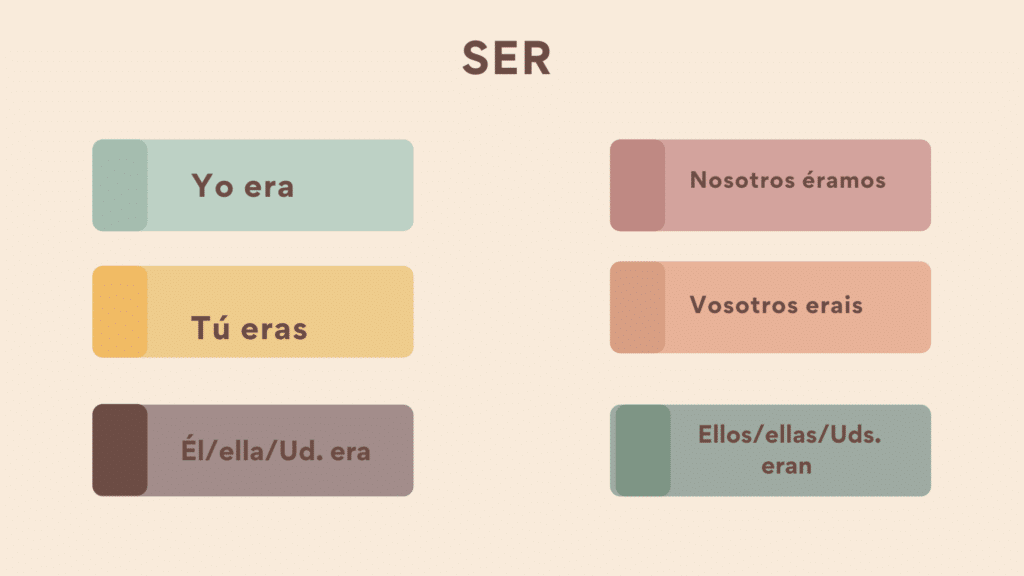Congratulations! You’ve mastered the present tense in Spanish, and now you’re ready to move on to the past tense.
It’s exciting to be able to move between tenses in a language and expand your ability to communicate even further and more precisely. It opens up a whole new world of being able to express yourself more fully and accurately.

However, if you’re an English speaker learning about the Spanish preterite tense and imperfect tense in class, chances are you’re a little confused about when to use each one.
After all, in the English language, we have just one past tense. But in the Spanish Language, as you’ve probably learned in class, there are two different past tenses: el pretérito and el pretérito imperfecto.
So let’s dive into these pesky spanish past tenses and clear things up once and for all.
Background Information (Preterite Tense)
First, let’s cover some background information about the uses of the preterite tense.
You’ve probably already learned that el preterito is used to describe past actions that occurred during a specific time frame (an hour ago, a week ago, one year ago, etc.). In other words, you use it when you’re talking about something occurred one specific time and now it’s over. It has a definite beginning and definite end.
For example, one might say “El otro día, comí una hamburgues deliciosa.” (The other day, I ate a delicious hamburger.) In this example, it’s correct to use the preterite tense because there is a specific time frame (the other day) and a definite end (I’m done eating the hamburger now. It happened once and now it’s over.)
You could say, “Ellos estudiaron ayer en la biblioteca.” (They studied yesterday in the library.) They studied in the library for a set period of time, and now it’s over.
The preterite endings for -ar verbs are: -é / -aste / -ó / -amos / -asteis / -aron
The preterite endings for -er/-ir verbs are: -í / -iste / -ió / -imos / -isteis / -ieron
Uses of the Imperfect Tense

Now, let’s focus on el imperfecto.
Here are some common uses of the Spanish Imperfect Tense:
1. Repeated / Continual Actions
The Spanish Imperfect Tense is used to describe past actions that were habitual actions, repeated actions, an ongoing action, or a continual action.
In other words, it’s used to indicate things that someone did repeatedly. This could be once in a while, sometimes, often, etc.
In English, we sometimes say things like “I used to eat ice cream every night” or “I would always laugh at his jokes” to communicate the same idea as the Spanish Imperfect Tense.
2. Descriptions of people/places/things
The Spanish Imperfect Tense is also used for descriptions of people, places, and things in the past. For example:
Ella tenía el pelo largo y una sonrisa bonita.
Direct Translation: She had long hair and a nice smile.
Yo era muy alto cuando era jóven.
Direct Translation: I was very tall when I was young.
El edificio no era en buenas condiciónes.
Direct Translation: The building was not in good condition.
3. Weather
Use a Spanish Imperfect Verb to describe the weather. This is a common use of the imperfect tense. Here are some examples:
Hacía sol pero estaba frío.
Translation: It was sunny but it was cold.
4. Trigger Words & Phrases
One rule of thumb, and one of the most efficient ways to decide whether to use the preterite or imperfect, is that any time you see the following phrases, you can bet that you will need to use the imperfect tense:
de vez en cuando (once in a while)
todos los dias (todas las semanas, todos los meses, etc.) (every day, every week, every month)
cada día (every day)
cuando era niña (niño) (When I was a child)
siempre (always)
casi siempre (almost always)
Normalmente (normally)
Usualmente (usually)
A menudo (often)
Con frecuencia / Frecuentemente (frecuently)
A veces (sometimes)
Casi nunca (almost never)
Nunca (never)
desde hacía (for/in a stretch of time)
When you see these phrases, you can know for sure that the sentence calls for a verb in the imperfect tense, because these all indicate habitual or ongoing actions.
Memorizing these phrases can be an effective way of improving your accuracy in deciding when to use the imperfect tense.
Imperfect Conjugations (Regular Verbs)
Now that you have a better understanding of when to use the imperfect tense, let’s look at some examples of spanish verbs with an imperfect ending.
The good news is that it’s actually one of the easiest tenses to conjugate! This is because the majority of verbs in the imperfect tense are regular. You just need to pay attention to whether the verb is an -ar verbs or an -er/-ir verb.
Here are the conjugations as well as some example sentences with the verbs being used in context:

-ar verbs
All you have to do is take off the -ar from the end of the verb and add the following endings:
yo: -aba
tu: -abas
el/ella/Ud.: -aba
nosotros: -ábamos
vosotros: -abais
ellos/ellas/Uds: -aban
*Note that the yo form and the Él/ella/Ud. form are exactly the same. You will need to use the pronoun or context to figure out who is performing the action.
*Note that in the above table there is only an accent mark in the nosotros/as form.
The following examples are -ar verbs in the imperfect tense with regular endings:
Hablar (to talk/to speak)
Yo hablaba
Tú hablabas
Él/ella/Ud. hablaba
Nosotros hablábamos
Vosotros habláis
Ellos/ellas/Uds. hablaban
Example Sentence:
Yo siembre hablaba con mi madre antes de acostarme.
Direct Translation: I would always talk with my mother before going to bed.
Trabajar (to work)
Yo trabajaba
Tú trabajabas
Él/ella/Ud. trabajaba
Nosotros trabajábamos
Vosotros trabajáis
Ellos/ellas/Uds. trabajaban
Example Sentence:
Cada día, mi padre trabajaba en la oficina por muchas horas.
Direct Translation: Every day, my dad would work in the office for many hours.
Practicar (to practice)
Yo practicaba
Tú practicabas
Él/ella/Ud. practicaba
Nosotros practicábamos
Vosotros practicáis
Ellos/ellas/Uds. practicaban
Example Sentence:
Ella practicaba al fùtbol a menudo después de escuela durante la semana.
Direct Translation: She used to practice soccer often after school during the week.
-er and -ir verb endings

The following table shows the endings for regular -er and -ir verbs:
Yo: -ía
Tú:-ías
Él/ella/Ud.: -ía
Nosotros: -íamos
Vosotros: -íais
Ellos/ellas/Uds.: -ían
Here are some examples with common verbs:
Comer (to eat)
Yo: comía
Tú: comías
Él/ella/Ud.: comía
Nosotros: comíamos
Vosotros: comíais
Ellos/ellas/Uds.: comían
Example Sentence:
Nosotros comíamos en nuestro restaurante favorito cada domingo después de iglesia.
Direct Translation: We used to eat in our favorite restaurant ever Sunday after church.
Hacer (to do/to make)
Yo: hacía
Tú: hacías
Él/ella/Ud.: hacía
Nosotros: hacíamos
Vosotros: hacíais
Ellos/ellas/Uds.: hacían
Example Sentence:
Ellas hacían ejercicio normalmente antes de ir a clase.
Direct Translation: They normally exercised before going to class.
Vivir (to live)
Yo: vivía
Tú:vivías
Él/ella/Ud.: vivía
Nosotros: vivíamos
Vosotros: vivíais
Ellos/ellas/Uds.: vivían
Example Sentence:
Cuando era niña, vivía en una casa pequeña en Guatemala.
Direct Translation: When I was a child, I lived in a small house in Guatemala.
Pedir (to ask for)
Yo: pedía
Tú: pedías
Él/ella/Ud.: pedía
Nosotros: pedíamos
Vosotros: pedíais
Ellos/ellas/Uds.: pedían
Example sentence:
Él pedía un refresco cada vez.
Direct Translation: He ordered a soda every time.
Irregular Conjugations in the Spanish Imperfect Tense
Regular imperfect verbs are relatively simple. In fact, it’s overall one of the easiest spanish tenses to conjugate.
However, there are irregular verbs in every tense. Spanish speakers know these automatically, but they will require memorization on the part of spanish learners until they become more natural.
The good news is that there are only three! Here are the three irregular verbs in the imperfect tense:
Ir (to go)
Yo iba
Tú ibas
Él/ella/Ud. iba
Nosotros íbamos
Vosotros ibais
Ellos/ellas/Uds. iban
Example Sentence:
Cuando yo era niña, iba a la iglesia cada domingo.
Direction Translation: When I was a child, I went to church every Sunday.
Ser (to be)
Yo era
Tú eras
Él/ella/Ud. era
Nosotros éramos
Vosotros erais
Ellos/ellas/Uds. eran
Example Sentence:
Tú eras un niño bien travieso.
Direct Translation: You were a really mischievous little boy.
Ver (to see)
Yo veía
Tú veías
Él/ella/Ud. veía
Nosotros veíamos
Vosotros veíais
Ellos/ellas/Uds. veían
Example Sentence:
Nosotros veíamos películas frecuentemente en los fines de semana.
Direct Translation: We watched movies frequently on the weekends.

Reflexive Verbs in the Imperfect Tense
As you may have already learned, reflexive verbs are verbs that require a reflexive pronoun, and they often indicate that something is being done to oneself. (For example, brushing one’s teeth, getting oneself dressed, etc.)
To conjugate reflexive verbs in the imperfect tense, you simply place the reflexive pronoun before the conjugated verb.
Here are some examples of -ar reflexive verbs conjugated in the imperfect tense:
Cepillarse los dientes (to brush one’s teeth)
Yo me cepillaba los dientes
Tú te cepillabas los dientes
Él/ella/Ud. se cepillaba los dientes
Nosotros nos cepillábamos los dientes
Vosotros os cepillabais los dientes
Ellos/ellas/Uds. se cepillaban los dientes
Afeitarse (to shave oneself)
Yo me afeitaba
Tú te afeitabas
Él/ella/Ud. se afeitaba
Nosotros nos afeitábamos
Vosotros os afeitabais
Ellos/ellas/Uds. se afeitaban
Here are some examples of -er/ir reflexive verbs conjugated in the imperfect tense:
Ponerse (to put on)
Yo me ponía
Tú te ponías
Él/ella/Ud. se ponía
Nosotros nos poníamos
Vosotros os poníais
Ellos/ellas/Uds. se ponían
Aburrirse (to get bored)
Yo Me abburía
Tú te abburías
Él/ella/Ud. se abburía
Nosotros nos abburíamos
Vosotros os abburíais
Ellos/ella/Uds. se abburían
Using the Preterite & Imperfect Together
Now that you’ve learned about the different uses of preterite vs. imperfect, you can begin to see how they might be used together in the same sentence.
They are sometimes used together when there is an an ongoing action (imperfect tense) and an interrupting action (preterite tense).
Yo estudiaba en la biblioteca cuando mi amigo me llamó.
Translation: I was studying in the library when my friend called me.
In the above example, I was studying in the library (an ongoing action) when my friend called me (the interrupting action). In this example, you use the imperfect tense to indicate the ongoing action – studying – and the preterite tense to indicate the interrupting action – your friend calling you.
Here’s another example:
Me acostaba cuando de repente mi hermano empezó a gritar.
Translation: I was going to bed when suddenly my bother started to yell.
In this second example, I was going to bed (an ongoing action) when suddenly my brother started to yell (an interrupting action that happened once).
It’s relevant to note here that both the preterite tense and the imperfect tense are considered simple past tenses. as you progress in Spanish, you will learn even more past tenses!
Conclusion
Spanish grammar can be tricky for a lot of people, but with practice and repetition, anything can become easier. These grammar lessons are meant to make the different uses of the Spanish Imperfect Tense more clear and easy to understand.
About the Author

Calie Herbst was a Spanish teacher in Milwaukee Public Schools for 10 years before running Milwaukee With Kids full time. She has lived and traveled in Spain, Mexico, Costa Rica, & Nicaragua.
Related Posts:
Calie Herbst, Editor-in-Chief of Milwaukee With Kids, has spent over a decade combining her experiences as a parent of three to create a hub for Milwaukee’s family adventures.
Her decade-long teaching career in Milwaukee Public Schools and academic background, including a Master’s in Teaching from Marquette University and dual B.A.s in Sociology and Spanish from the University of Wisconsin – Madison, fuel her passion for inclusive and engaging family content.
Calie is also a recognized voice in local media, contributing to WISN Channel 12 News, WTMJ Wisconsin Morning News, Fox 6’s Real Milwaukee, and B93.3.
Discover more about Calie’s journey and editorial approach on her About Page and Editorial Policy Page.








